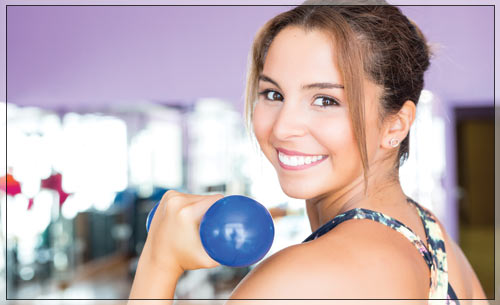
While gyms were closed during the COVID-19 pandemic, many individuals were left to their own devices; some relied on steaming programs or exercised with a socially distanced friend to stay fit.
According to the U.S. Department of Health and Human Services, the average adult should get about 150 minutes of moderate aerobic exercise each week, which equates to 20 – 30 minutes of physical activity per day.
However, simply going for a walk around the neighborhood is often not enough. An effective fitness routine takes the following factors into account.
Activity Types and Levels
To avoid reaching a fitness plateau, aim for a combination of these factors in your exercise routine.
Aerobic Activity
Typically called “cardio”, aerobic activity gets you breathing faster which elevates your heart rate, releases more oxygen into your blood, and delivers it to your muscles and lungs. Aerobic exercises include walking, jogging, biking, swimming and dancing. In your everyday life, cardio can even encompass maintenance around your home, like vacuuming or shoveling snow.
If you’re looking to make a more meaningful impact with your workout routine, consider high-intensity interval training. This entails breaking up your typical aerobic activities with short bursts of higher-intensity movement, like jump squats.
Strength Training
These routines target your muscles, which can assist with weight loss and increase bone strength. Ideally, strength training should cycle through all muscle groups on a weekly basis.
Core Exercises
Core strength contributes directly to your posture, which can affect form and impact the effectiveness of your fitness routine. Focusing part of your fitness routine on muscles in the lower back, pelvis and abdomen ultimately allows you to get better results and reduces your injury risks.
Core-strengthening exercises typically target the trunk of your body and encompass planks, sit-ups, bridges and medicine-ball exercises.
Balance Training
Those in their 20s and 30s might not be thinking about balance but this aspect of physical stability can worsen with age, especially through neuropathy, vision problems and decreased flexibility.
Older adults with poor balance also have a higher likelihood of experiencing a head injury or fall, which could result in a fractured or broken hip. Balance exercises help to strengthen areas that can reduce potential falls, fractures and tie into core strength.
Flexibility
Also known as stretching and mobility training, flexibility often encompasses your warm-up and exercises to improve posture, range of motion in the joints and any tension in your body. Stretching exercises include activities like yoga and Pilates, which should be done two to three times a week.
Long term, focusing on flexibility for 15 minutes before you begin a workout routine can lessen your risk of experiencing a slipped disk or rotator cuff injury.
Sense of Structure
Fitness routines quickly fall apart when you don’t plan out your week and set goals. In turn, sticking to and making the most of your routine involves:
- Scheduling time for cardio, strength training and other activities. This includes weekends!
- Trying new routines to avoid boredom. Consider walking some days, using a set of weights on others and, if you have access to one, a pool to swim laps. This approach can further prevent overworking certain parts of your bodies while others atrophy.
- Giving yourself time to recover. Anticipate your body will feel sore the next day, especially if you just tried something new.
- Starting slow and building up momentum. Schedule adequate warm-ups and cool downs, avoid overuse, and aim for at least 30 minutes of activity per day, gradually ramping up your routine every six weeks.
- Changing your goals, in terms of miles, speed, duration and weight, to always be working toward a new goal.
Gear and Form
The right gear can make all the difference and directly impacts your form. For your fitness routine to be effective and injury-resistant, first make sure you’re wearing the right shoes and that the equipment you’re using is not broken.
Also pay attention to your apparel: Look for breathable, wicking fabric that won’t constrict the skin.
Once you have the right setup, focus on your form:
- Stand up tall and lift your chest, avoid slouching and stare ahead.
- Make sure your shoulders remain pushed back and down.
- Keep your toes pointed forward.
- Support your body weight between the heel and ball of your foot.
In addition to these guidelines, have one of our team members point you in the right direction and monitor your progress. Contact us to schedule an appointment.

